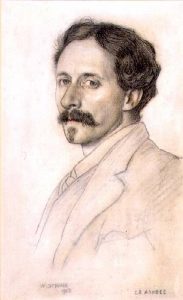Case three: The Essex House Press
Charles Robert Ashbee (1863-1942), an architect by training, brought together a group of designers and artists to form a collective called the Guild of Handicraft in 1888. They sought to learn, develop and teach new skills in craftsmanship, and shared a common interest in simple living for both the spiritual and physical health of the craftsman.
Ashbee admired William Morris immensely, but never found favour with the designer because of his less radical social reform model, which focused on the workshop rather than on the individual and did not shy away from the use of some machinery. After Morris’s death in 1898, however, Ashbee was finally able to participate in the great designer’s work. He purchased the Kelmscott Press’s equipment and moved it to the Guild of Handicraft in Whitechapel, designing types similar to Morris’s, using the same ink and vellum paper and even hiring on the Kelmscott printers. This venture became known as the Essex House Press.
“The great event of the week has been the purchase of the Morris Press by the Guild of Handicraft. Great jubilation! …So next Monday there will be vans of presses and gages, and chairs and tables and paper and the machinery – lock stock and barrel moving East from Hammersmith. We are thinking of a musical procession. We engage Morris’s printers and carry on the great tradition.”
B.G. Burrough, ‘Three Disciples of William Morris, 2. C.R. Ashbee’, Connisseur, 172 (Oct. 1969), 90.

